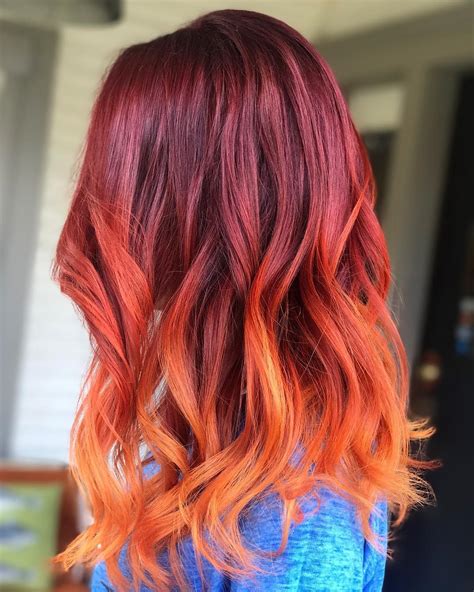Introduction
Hair ombre color is a stunning technique that involves gradually blending two or more hair shades to create a seamless transition. This versatile trend has captured the hearts of fashionistas worldwide, offering endless possibilities for self-expression.

Benefits of Hair Ombre Color
- Enhances volume: Gradated hues add depth and dimension to hair, creating the illusion of fuller, thicker locks.
- Complements all face shapes: Ombre color can be customized to flatter any facial features, enhancing your natural beauty.
- Low maintenance: Unlike solid hair colors, ombre roots blend naturally with new hair growth, reducing the need for frequent touch-ups.
- Versatile: Ombre color can be achieved on any hair texture or length, providing endless styling options.
- Trendy and timeless: Ombre color has been a popular trend for over a decade, but it continues to evolve with new and exciting variations.
Types of Hair Ombre Color
1. Classic Ombre:
– Involves blending two shades in a gradual transition from dark roots to lighter ends.
– Suitable for all hair colors and textures.
2. Reverse Ombre:
– Features lighter roots that gradually transition to darker ends.
– Creates a dramatic and unique look.
3. Shaded Ombre:
– Blends multiple shades of the same color, creating a subtle yet sophisticated effect.
– Perfect for achieving a natural-looking sun-kissed glow.
4. Rooted Ombre:
– Leaves a significant portion of the roots untouched, creating a more dramatic and edgy look.
– Ideal for those who want to maintain their natural hair color while experimenting with ombre.
How to Choose the Right Hair Ombre Color
- Consider your skin tone: Warm skin tones complement golden and honey-blonde shades, while cool skin tones suit ash and platinum shades.
- Match your hair texture: Fine hair requires lighter shades to create volume, while coarse hair can handle darker, bolder colors.
- Personalize your style: Ombre color can be customized to reflect your personality and preferences.
- Seek professional advice: Consult with a hairstylist to determine the best ombre technique and shades for your hair type and desired look.
Hair Ombre Color Statistics
- According to a survey conducted by Salon Today, ombre color accounted for 45% of all hair color services in 2020.
- The popularity of ombre color is expected to continue growing in the coming years, with over 50% of salons offering the service by 2025.
- Ombre color is particularly popular among millennials and Gen Z, who account for over 70% of ombre clients.
Tips for Caring for Ombre Hair
- Use color-safe shampoo and conditioner to protect the vibrancy of the hues.
- Limit heat styling to prevent damage and fading.
- Deep condition your hair weekly to restore moisture and prevent breakage.
- Get regular trims to remove split ends and maintain the desired shape of the ombre.
- Avoid harsh hair products, such as bleach and chemical relaxers, as they can damage the hair and affect the ombre color.
Pros and Cons of Hair Ombre Color
| Pros | Cons |
|---|---|
| Adds volume and depth | Can be time-consuming and expensive |
| Customizable to suit any style | Requires regular maintenance |
| Low maintenance compared to solid colors | Not suitable for all hair textures or colors |
| Trendy and versatile | Can fade or become brassy if not properly cared for |
FAQs about Hair Ombre Color
-
How long does it take to get ombre hair?
– It typically takes 3-6 hours, depending on the length and thickness of your hair. -
Is ombre color damaging to hair?
– Ombre color can cause some damage, especially if it involves bleaching. Proper care and maintenance are essential to minimize damage. -
How often should I get my ombre color touched up?
– Touch-ups are generally recommended every 6-8 weeks to blend roots and maintain the desired color transition. -
Can I do ombre color at home?
– It is not recommended to attempt ombre color at home, as it requires professional techniques and products to ensure the desired results. -
Is ombre color suitable for all hair colors?
– Ombre color can be achieved on most hair colors, but it may be more effective on certain shades than others. -
What is the difference between ombre and balayage?
– Ombre involves a more gradual and defined blend of colors, while balayage is a freehand technique that creates softer, more natural-looking highlights. -
How can I maintain the vibrancy of my ombre color?
– Use color-safe products, limit heat styling, and deep condition your hair regularly. -
Is ombre color still in style?
– Ombre color remains a popular and versatile trend, offering endless styling possibilities.
Conclusion
Hair ombre color is a transformative and stylish technique that can enhance your natural beauty and express your personal style. Whether you prefer a classic ombre, a shaded ombre, or a rooted ombre, there is a variation to suit every hair color, texture, and face shape. By understanding the different types of ombre color, choosing the right shades, and following proper care tips, you can achieve stunning ombre hair that will turn heads for years to come.
